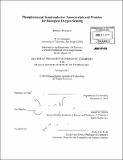Phosphorescent semiconductor nanocrystals and proteins for biological oxygen sensing
Author(s)
McLaurin, Emily J. (Emily Jane)
DownloadFull printable version (19.47Mb)
Other Contributors
Massachusetts Institute of Technology. Dept. of Chemistry.
Advisor
Daniel G. Nocera.
Terms of use
Metadata
Show full item recordAbstract
Oxygen is required for cellular respiration by all complex life making it a key metabolic profiling factor in biological systems. Tumors are defined by hypoxia (low pO2), which has been shown to influence response to radiation therapy and chemotheraphy. However, very little is known about spatio-temporal changes in P0 2 during tumor progression and therapy. To fully characterize and probe the tumor microenvironment, new tools are needed to quantitatively assess the microanatonical and physiological changes occurring during tumor growth and treatment. This thesis explores the design and construction of new oxygen sensors as tools for monitoring the tumor microenvironment in real-time. Semiconductor nanocrystals or quantum dots (QDs) are the basis of these tools. Previously, most imaging applications of QDs have used them as indicators of position; they have lacked a response to their local environment. Tethering a phosphorescent complex to a QD enables fluorescence resonance energy transfer to be exploited as a signal transduction mechanism, sensitizing the QD to oxygen. The mechanism for oxygen sensing involves kinetic quenching of the emission of the energy accepting phosphor in the presence of oxygen, while the emission of the energy donating QD remains stable. This mechanism was chosen owing to the unique ability of oxygen to quench emission from a phosphorescent compound, but not fluorescence from a QD. Phosphors such as osmium polypyridines (Chapter 2), Pd or Pt porphyrins (Chapters 3 and 4), or phosphorescent proteins (Chapters 5 and 6) may all be employed. An additional benefit of FRET excitation includes very large one- and two-photon excitation cross-sections of QDs. Together, these properties make the probes ideal candidates for 02 sensing applications in biological microenvironments, where probe concentrations may vary, and where the use of multiphoton excitation in microscopy presents significant advantages in imaging thick samples and in limiting extraneous tissue damage.
Description
Thesis (Ph. D.)--Massachusetts Institute of Technology, Dept. of Chemistry, 2011. Vita. Cataloged from PDF version of thesis. Includes bibliographical references.
Date issued
2011Department
Massachusetts Institute of Technology. Department of ChemistryPublisher
Massachusetts Institute of Technology
Keywords
Chemistry.